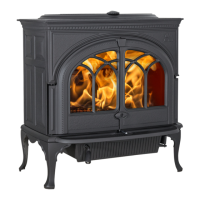MAINTENANCE:
Ash removal: Of course, for your protection always
wear safety gloves when handling the ash pan.
Ash removal will be required periodically depending on
how frequently the stove is used. Conveniently, the
Fightlight CB is equipped with an ash pan assembly for
easy ash removal, without the need for opening the front
doors.
The ash pan door is located under the front ashlip of the
stove. To open the ash door insert the pin on the end of
your specially designed ash tool into the hole on the ash
door latch. Rotate the door counterclockwise to unlatch
the door and clockwise to latch the door.
Remove the ash pan. When the stove is in operation
always close the ash door before leaving to dispose of the
ashes.
The ashes should be placed in a metal container equipped
with a tight sealing lid. The container should be placed on
a noncombustible floor or on the ground, well away from
all combustible materials, pending final disposal. If the
ashes are disposed of by burial in soil or otherwise locally
dispersed, they should be retained in the closed container
until all cinders have thoroughly cooled.
With the primary air control lever in the full open position,
start with several sheets of crumbled newspaper placed
directly on the grate. On top of the newspaper, place
several pieces of small dry kindling (approx. 1 in
diameter) with two to three larger logs (approx. 3 to 5
in diameter) on top.
Light the fire and close the door, slowly building the fire
by adding larger and larger logs. Be sure to follow the
break-in procedure before creating a fire that will damage
the stove.
Once the stove has reached a surface temperature range
of between 400° and 600°, adjust the primary air control
lever as necessary to generate the heat output and burn
time desired.
Jøtul recommends the use of a magnetic stove top
thermometer to monitor the surface temperature of the
stove. The optimum surface temperature range for the
most efficient burn is between 400° to 600°. See figure
12 below for the optimum locations of a stove-top
thermometer.
Adding Fuel
When reloading the stove while it is still hot and a bed of
hot embers still exist, follow this reloading procedure:
· Always wear gloves when tending to the stove.
· Push the air control lever to the full open position
(far right).
· Wait a few seconds before opening the door.
· Use a stove tool or poker to distribute the hot embers
equally around the firebox.
· Load the fuel, usually with smaller logs first.
· Close the door, be sure to latch the door tightly.
· Wait 5 10 minutes before adjusting the primary air
to the desired heat output setting. (If you have at least
a 2 thick ember bed when reloading, it may be
possible to close the door and immediately adjust the
air control setting).
14
STOVE-TOP
THERMOMETER
FIGURE 12
The Formation of Creosote
When wood is burned slowly and at low temperatures, it
produces tar and other organic vapors, which combine
with moisture to form creosote. The slow moving smoke
carries the creosote vapors, which condense in the cooler
chimney flues, and this creosote then sticks to the chimney
walls.
The creosote that accumulates in the chimney is highly
flammable and is the fuel of chimney fires. To prevent
chimney fires it is important to have the chimney and
chimney connector pipe inspected and/or cleaned semi-
annually. A qualified chimney sweep or other authorized
service person can provide this service.
It is also important to remember that chimney size,
temperature and height all affect draft which in turn affects
the formation of creosote. Be sure to follow the installation
and operation guidelines established in this manual.
STOVE-TOP
THERMOMETER

